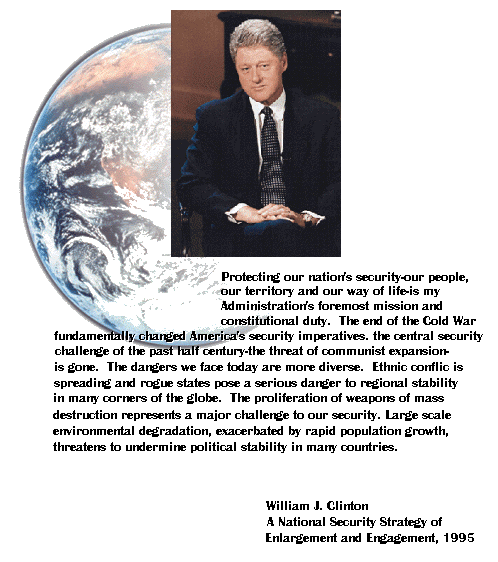

The end of the Cold War has created opportunities for greater peace and prosperity as well as new challenges to our nation's security. To seize the opportunities and meet the challenges of the post Cold War era, the Administration has developed a comprehensive approach to putting science and technology to the service of national security and global stability. This National Security Science and Technology Strategy recognizes that our nation's security rests on three pillars: the readiness and capabilities of our military forces, our engagement with other nations to prevent conflict from occurring, and the strength of our economy. The strategy supports the Administration's overall national security policies as articulated in A National Security Strategy of Engagement and Enlargement and is grounded in the conviction that advances in science and technology are a vital part of the solution to many of the problems that we face.
A central theme of the Administration's national security policy is the prevention of conflict combined with a readiness to use force, should force be required. Key to this theme is a priority on engagement with other nations. Rather than isolate a state as we did the Soviet Union, we now seek to integrate states such as Russia, China, and others into a larger political and economic order, creating a web of relationships-including scientific and commercial relationships-that give us a shared interest in stability.
For the past five decades, our nation's investment in its science and technology enterprise has been central to ensuring our position as a global leader. U.S. military capabilities and economic prosperity, as well as sustained global economic development are all advanced by progress in science and technology. However, the challenges of international leadership and national security are growing more complex, resulting in greater demands than ever on our investment resources. This National Security Science and Technology Strategy describes how our nation's investments in science and technology support our overall national security objectives in this evolving environment.
Military capabilities second to none. Military strength is essential both to prevent and respond to conflict. Unparalleled military capabilities can dissuade an aggressor and enable the United States to act decisively in times of crisis, and technological superiority is essential to our military advantage. For example, stealth, precision guidance, and advanced communications-all products of science and technology-are critical to military success. Although the United States has reduced its nuclear arsenal, we will retain strategic nuclear forces sufficient to deter nuclear attack against the United States, our friends, and allies and to convince future hostile governments that seeking a nuclear advantage would be futile.
However, the use of military force can be costly in American lives and national resources. Because the costs of responding to conflict can quickly outweigh the costs of preventing conflict from occurring in the first place, this Administration places a high priority on conflict prevention.
Engagement for the prevention of proliferation. Conflict prevention requires that we not only maintain superior military capabilities but that we address sources of instability as well, including the arms race dynamic that accompanies the accumulation of advanced weaponry by regional powers. Preventing the proliferation of weapons of mass destruction-and countering those that do spread-is a priority that requires both science and technology investments and cooperation. This Administration is expanding and accelerating its cooperation with the States of the former Soviet Union to dismantle the massive arsenals left from the Cold War at an accelerated pace; to ensure that weapons and weapons materials are secure and accounted for; and to employ former weapons scientists in needed civilian research. This Administration is also working to strengthen international efforts to stem the spread of weapons of mass destruction and their delivery systems including new agreements and improved safeguards. Advances in detection and monitoring technologies are fundamental to arms control treaty verification, nonproliferation, and counterproliferation.
Addressing root causes of conflict. The strategy of conflict prevention also addresses the sources of stress that lead to instability. Endemic poverty, overpopulation, food and resource scarcity, environmental degradation, and the spread of infectious disease can lead to mass migrations, the breakdown of civil order, and ultimately conflict. Mitigating these stresses demands the sustained engagement of many nations, rather than the occasional interventions of one. Cooperation in science and technology plays a vital role in addressing these sources of conflict by contributing to sustained economic development, by building capacity in science and technology, and by promoting the advancement of knowledge.
Building from a strong economy. This Administration recognizes that our nation's security derives from a combination of economic strength and military might. A strong economy provides the United States with the resources for leadership in international affairs. A vibrant high-technology industrial sector enhances our national economic performance while providing the technological base that underpins advanced military capabilities. Policies to accelerate scientific discovery and technological innovation are thus of high priority to this Administration. A key aspect of this effort is international science and technology cooperation which contributes to the development of free market economies, while helping to create and expand markets for U.S. goods and services.
Finally, underlying this strategy is a recognition that the Federal Government is but one player in advancing the security of our nation. Industry, academia, nongovernment organizations, and individuals also play important roles. For example, throughout the Cold War, Western scientists and scholars worked with their Soviet counterparts to advance scientific discovery and build a basis for cooperation in arms reduction and nonproliferation. By sustaining and expanding these professional ties in the post-Soviet era, they can strengthen the Russian scientific community, which is a force for political reform and whose participation in the Russian economy is essential to economic reform. New private-sector investments in economies in transition can fuel economic growth that is the basis for political stability.
The National Security Science and Technology Strategy reflects the complexity of the new security environment, sustains our traditional strengths, and enhances our capacity to meet evolving challenges to the long-term security of our nation.


